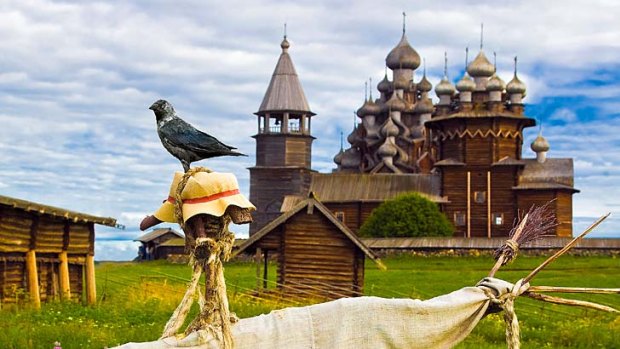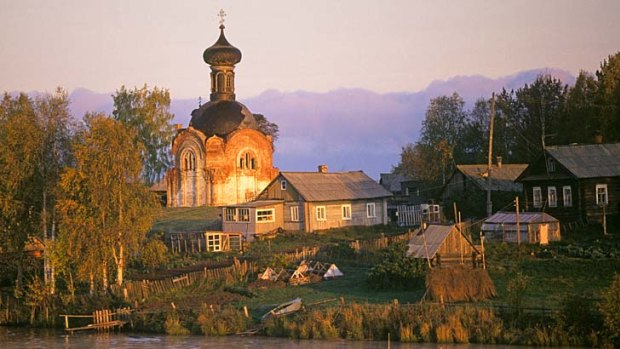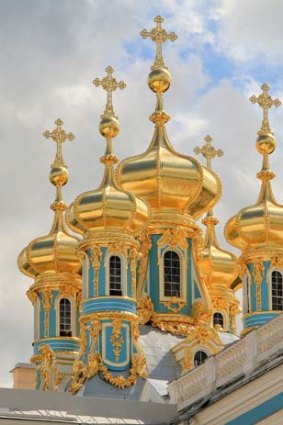
Course of history... Kizhi's wooden churches.Credit: Alamy
Brian Johnston sails into a land of monks, murder and majesty on the river route from Moscow to St Petersburg.
There are few reminders of the old days in Moscow. True, occasional profiles of Lenin hang forgotten on buildings and muscled workers scythe wheat on friezes in metro stations. But in my outdated mind, there ought to be Soviet leaders in duffel coats grimacing as they leave the Kremlin and secret police loitering in the shrubbery. Instead, the Kremlin is a place of chirpy Chinese tourists, who giggle when chisel-cheeked guards blow their whistles.
So I'm pleased that my ship is docked at the Northern River Terminal, a glum 1930s Soviet building perfectly suitable for a le Carre dead drop. Its dilapidation is a reminder of an abandoned philosophy, but the linking by water of Moscow and St Petersburg is a more lasting Soviet achievement.

A church and dachas on the Volga.Credit: Alamy
Stalin completed the interlinking canals, rivers and lakes by flooding 700 villages to create massive reservoirs on the Volga and Sheksna rivers. In the days ahead, we pass steeples sticking out of the water in mournful reminder of the whims of dictators.
I'm just finishing lunch on our vessel, the Viking Surkov, when ripples appear in my coffee and the ship pulls away from the wharf, sliding past cranes and rusting metal. Soon we've left the suburbs behind, and the Moscow Canal is lined by little blue-doored dachas hunkered beneath damp yellow birch trees. Night comes quickly at this time of year. The tranquil, slow-gliding beauty of autumn colour soon dissolves, and only lighted windows gleam in the darkness.
The Viking Surov makes its way overnight on to the legendary Volga River. Uglich is an ugly name for a pretty town sitting on the riverbank, where wedding-cake churches are yellow and red, trimmed with whimsy against a blue autumn sky. Our ship is greeted by ragged boys selling bunches of wilting flowers that look as if they've been plucked from the gardens of outraged babushkas.

St Petersburg spires.Credit: Getty Images
A nine-year-old boy called Dmitry, son of Ivan the Terrible, made Uglich infamous in 1584 when he was dragged down the steps of his palace here and murdered in front of his mother, probably at the instigation of Boris Godunov. The killing is depicted with grim delight in the pocket-size Church of St Dmitry of the Blood, as is the revenge the Uglich townspeople exacted on Godunov supporters.
These are scenes of startling violence for a church, especially one with a jaunty gingerbread exterior and star-studded blue dome. We've sailed into the legends of old-time Russia, a place of cruel majesty, mad bearded monks, murder and mayhem, whose shocking stories are recounted by guides with matter-of-fact cheerfulness.
By the time we reach Yaroslavl early next morning, the Volga is huge and sluggish. In the 17th century, rich river merchants tried to outdo each other (and their Muscovite rivals), building mansions and churches; domes bulge everywhere and wrought-iron railings surround grand buildings.
Fur traders were responsible for the cultural highlight, the frescoed Church of Elijah the Prophet. Biblical stories in soft blue and green hues cover arches and ceilings and are among the best surviving examples of Old Russian art anywhere.
Yaroslavl also has an impressive fortified monastery that, in one of the frustrations of tight tour itineraries, is only glimpsed from our passing tour coach. Still, we get some free time, and I discover a lovely town of promenades high on a river bluff, and a central market crammed with pickle jars and slabs of cheese.
Neighbourhood churches are dark and dramatic, sauna-hot and shimmering with candles. Priests have wild grey beards and wear hats like puddings. I look for Rasputins but see only chubby leprechauns whose vestments are sprinkled with glittering green embroidery.
As we sail north the air becomes crunchy-cold. Larch turns to pine along the riverbanks. The landscape is flat, the sky huge and haunting. I gaze mesmerised out of my cabin window at this seemingly endless land, a kind of cold Russian outback where bears are common and beetroot farmers and mushroom pickers scratch a living.
The slow passing of the landscape adds to the cocooning effect of life on the Viking Surkov, where everything is easy and gargantuan meals are a recurring temptation.
Long distances mean this cruise has less-frequent shore excursions than many in Europe, but the passing scenery is mesmerising and on-board lectures cover Russian history and society. The real Russia of traffic jams and social upheaval leaks out at the edges of its program, and lectures tell it the way Russians see it: Gorbachev terrible, Putin rather good, Catherine not so great. Dinners are often enlivened with animated post-lecture discussion.
Three days after leaving Moscow, we dock in Kuzino for an excursion to Kirillo-Belozersky Monastery, founded by St Cyril in 1397. The monastery on Lake Sovetskoye makes for the least impressive of our shore excursions. It might once have been Russia's biggest and most prosperous monastery, but now it has an abandoned feel, peeling paintwork and just a few surviving icons of saints with doleful, drooping eyes. I prefer the drive through the surrounding village of lopsided wooden houses with picket fences.
Soon we're sailing along the Vytegra Canal, with its locks and hydro-electric stations. Here, pine forests produce lumber and painted wooden villages alternate with rusting industrial towns. These half-hearted trappings of modernity peel away as we're coughed out into Lake Onega, a vast body of brown, mineral-rich water fed by 50 rivers and fringed by stands of elm, lime and pine.
Kizhi's old wooden barns, windmills and farmhouses, reassembled from across north-west Russia, are straight out of a fairytale about snowbirds and winter queens. Sandwiched between the super-sized excesses of Moscow and the baroque opulence of St Petersburg to come, Kizhi is a glimpse of another Russia, of peasants and fishermen leading a rough-hewn life under frigid skies. "The only difference between summer and winter here is that our fur coats are unbuttoned in summer," says impish local guide Natalia, enveloped in several layers of frayed coats. "Our climate conditions are very severe. First comes the icebreaker and then the tourist boats in May. But despite the bad weather, no one is indifferent to these beautiful views."
Natalia says it's a guidebook myth that Kizhi's 16th-century wooden churches are built without nails. In any case, the Church of the Transfiguration is a rustic beauty whose 22 wooden domes seem as organic as mushrooms. This is the summer church and is closed up tight against the Arctic wind. Next door, the winter Church of the Intercession is a mini-me kept warm by elevated floors and pot-bellied stoves. Its barn-like simplicity, rustic painted icons and bunches of wildflowers are a touching contrast to the sinister opulence of Kremlin cathedrals.
The magical aspen-shingled silver domes of Kizhi's churches turn purple in the late light, floating above lake-moated meadows. A startling sunset sets larch trees on fire. Next morning, there are pancakes and berries for breakfast as we glide through the mist beside the elk-inhabited forests of the Svir River.
Kizhi is rural Old Russia, as genuine as moss on a tree trunk or the yoghurt on rye bread that provides a local staple. Our next stop, Mandrogi, is a sentimentalised 1997 re-creation of the same thing. Long-haired men in tunics paint icons and Russian dolls as if they've just wandered in from the backwoods to practise their humble art but, when I talk to them, I discover they're actually St Petersburg university students.
The Svir River spills us into Lake Ladoga. In the early morning I miss Petrokrepost, a fortress captured from the Swedes in 1702 by Peter the Great. It marks the start of the Neva River, the last short haul to St Petersburg. At first there are just more trees, then sawmills and stacked logs, then dachas. Days of remote wilderness leave me unprepared for the appearance of suburbia. I don't want this slow-moving, cloud-scudded, tree-lined cruise to end. Or maybe I do. Ahead lies the glittering, golden improbability of palaces and marvels that is St Petersburg, and perhaps the best is saved for last.
Brian Johnston travelled in Russia courtesy of Viking River Cruises.
FAST FACTS
Getting there
Emirates has a fare to St Petersburg from Melbourne and Sydney from $1854, low season return, including tax. Fly to Dubai (about 14hr), then to St Petersburg (6hr 35min); see emirates.com/au.
Cruising there
Viking River Cruises has a 13-day Waterways of the Czars cruise between Moscow and St Petersburg (or reverse) from $4499 a person, including meals on-board, lectures and most shore excursions. Phone 1800 829 138; see vikingrivercruises.com.au.
Sign up for the Traveller Deals newsletter
Get exclusive travel deals delivered straight to your inbox. Sign up now.